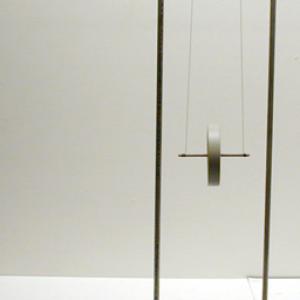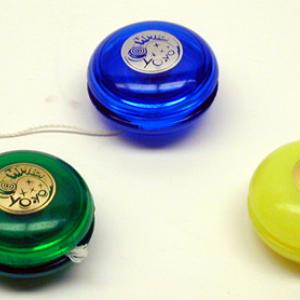College of Liberal Arts & Sciences
1M40.50 - Yo-Yo's and Maxwell's Wheel - Speed of Translation
Video and Editing Credit: Jonathan M. Sullivan-Wood.
Attach the cross rod with the Maxwell's wheel to the support assembly and make sure that it is secured tightly. Hang the support assembly from the Newton scale and the scale from the special hook clamp. Add 2 kg + 4 lbs of mass to the support assembly. This combination has been picked to give a good time scale for the spring deflection. The Maxwell's wheel will only appear to be heavier at the bottom of its stroke in relation to its rest mass. It will show no apparent affect at the top of its stroke due to inherent physical construction and parameters.
The Maxwell's wheel can also be used to measure the speed of translation using a photogate, motion sensor, or rotary motion sensor.
The strings of the yo-yo's may have to be twisted and wound several times before they work well. As usual practice makes perfect.
- Leonid Minkin, Daniel Sikes, "Yo-Yo Jerk Dynamics in the Vicinity of the Lowest Point", TPT, Vol. 58, #9, Dec. 2020, p. 656.
- Isabel Salinas, Martin Monteiro, Arturo C. Marti, Juan A. Monsoriu, "Analyzing the Dynamics of a Yo-Yo Using a Smartphone Gyroscope Sensor", TPT, Vol. 58, #8, Nov. 2020, p. 569.
- Juan F. Carrau, Vinicius Cappellano De Franco, Marcos L. Andreazza, Odilon Giovannini, Claudio A. Perottoni, "The Anharmonic Rotating Wheel", TPT, Vol. 43, #5, May 2005, p. 349.
- Barbara Pecori and Glacomo Torzo, "The Maxwell Wheel Investigated with MBL", TPT, Vol. 36, # 6, p. 362, Sept. 1998.
- William Boudreau, "Cheap and Simple Yo-Yos", TPT, Vol. 28, # 2, Feb. 1990, p. 92.
- H. Richard Crane, "Help for Forgetful Car Owners and Lazy Yo-Yo Throwers", "The Automated Yo-Yo", TPT, Vol. 26, # 4, Apr. 1988, p. 240.
- Ms- 2, Freier and Anderson, A Demonstration Handbook for Physics.
- M- 83, Richard Manliffe Sutton, Demonstration Experiments in Physics.
- 8.3, Harry F. Meiners, Physics Demonstration Experiments, Vol. I, p. 149.
- Robert Ehrlich, "E.3, Rolling a Wheel with Axle Down a Slight Incline", Turn the World Inside Out, p. 53.
- Jodi and Roy McCullough, "Conservation of Energy with a Yo-Yo", The Role of Toys in Teaching Physics, p. 4.94.
- Jodi and Roy McCullough, "Moment of Inertia with a Yomega Yo-Yo", The Role of Toys in Teaching Physics, p. 4.106.
- "Making and Using the 'Bandilore'", The Boy Mechanic Makes Toys, p. 211.
- Jearl Walker, "1.85, Yo-Yo", The Flying Circus of Physics Ed. 2, p. 43.
- Ed Sobey, Woody Sobey, "Yo-Yo", The Way Toys Work, p. 171.
- Robert L. Wild, "Falling Spool Tied to a Balance", Low-Cost Physics Demonstrations, # 48, p. 32.
- 2.47, Jearl Walker, "The Flying Circus of Physics with Answers".
- Julius Sumner Miller, Physics Fun and Demonstrations, p. 11, 101, 117
- Kurt Przybilla, TetraTops Teacher's Guide, Duncan Toys.
- Kurt Przybilla, Tetra Tops Teacher's Supplement, Duncan Toys.
- Dr. James Watson, Nancy Watson, Teacher's Guide: Teaching Science with the Yo-Yo, Duncan Toys, 1996
- Dr. James Watson, Nancy Watson, Teaching Science with the Yo-Yo, Duncan Toys.
Disclaimer: These demonstrations are provided only for illustrative use by persons affiliated with The University of Iowa and only under the direction of a trained instructor or physicist. The University of Iowa is not responsible for demonstrations performed by those using their own equipment or who choose to use this reference material for their own purpose. The demonstrations included here are within the public domain and can be found in materials contained in libraries, bookstores, and through electronic sources. Performing all or any portion of any of these demonstrations, with or without revisions not depicted here entails inherent risks. These risks include, without limitation, bodily injury (and possibly death), including risks to health that may be temporary or permanent and that may exacerbate a pre-existing medical condition; and property loss or damage. Anyone performing any part of these demonstrations, even with revisions, knowingly and voluntarily assumes all risks associated with them.


